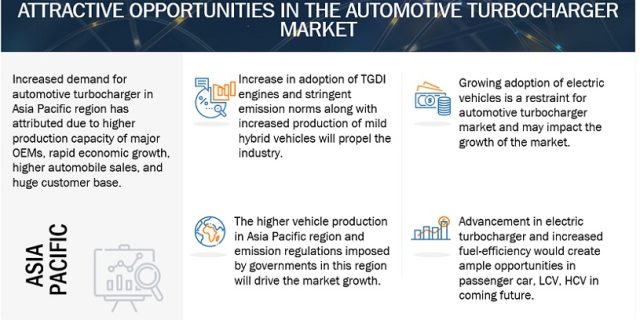
The automotive turbocharger market is projected to grow from USD 15.2 billion in 2024 to USD 22.9 billion by 2030, at a CAGR of 7.1%. The growth of the automotive turbocharger market is propelled by harsh emission regulations and shifting consumer inclination for high-performance vehicles. As the automotive industry is transitioning from diesel to gasoline light-duty vehicles and a surge in vehicle hybridization, there could be a promising opportunity for turbocharger manufacturers in gasoline and hybrid variants.
The automotive turbocharger market is experiencing notable growth and innovation, driven by several key factors:
- Stricter Emission Regulations: Stringent emission standards imposed by governments worldwide are compelling automotive manufacturers to adopt turbocharging technology to improve fuel efficiency and reduce emissions. Turbochargers enable downsizing of engines without sacrificing performance, allowing vehicles to meet regulatory requirements while maintaining power output.
- Demand for Fuel Efficiency: Rising fuel prices and growing environmental concerns are driving consumers to seek more fuel-efficient vehicles. Turbochargers enhance engine efficiency by increasing power output without significantly increasing fuel consumption, making them an attractive solution for both gasoline and diesel-powered vehicles.
- Shift towards Downsized Engines: The trend towards downsized engines, particularly in passenger cars, is fueling the demand for turbochargers. Downsizing involves using smaller displacement engines with turbochargers to deliver the power of larger engines while consuming less fuel. This trend not only improves fuel efficiency but also reduces vehicle weight and emissions.
- Performance Enhancement: Turbochargers are valued for their ability to boost engine performance, providing increased horsepower and torque compared to naturally aspirated engines. This appeal extends beyond fuel efficiency to enthusiasts seeking sportier driving experiences, leading to the integration of turbochargers in performance-oriented vehicles across various segments.
- Technological Advancements: Ongoing advancements in turbocharger technology, such as twin-scroll, variable geometry, and electric turbochargers, are enhancing performance, efficiency, and response times. These innovations address challenges like turbo lag, optimize airflow management, and improve overall engine performance across a wide range of operating conditions.
- Expansion in Emerging Markets: Growing automotive markets in regions like Asia-Pacific and Latin America present significant opportunities for turbocharger manufacturers. As these regions experience economic growth and rising vehicle ownership rates, there’s an increasing demand for turbocharged vehicles that offer a balance of performance and fuel efficiency.
- Electrification Trends: The emergence of hybrid and electric vehicles is reshaping the automotive landscape, but turbochargers still play a role in hybrid powertrains, known as “e-boosting.” Electric turbochargers and other electrified boosting technologies are being developed to complement electric powertrains, providing instantaneous power delivery and enhancing overall efficiency.
- Aftermarket Demand: The aftermarket segment for turbochargers is also growing as enthusiasts and tuners seek to upgrade their vehicles for improved performance. Aftermarket turbocharger kits and components cater to a diverse range of applications, from street performance to motorsport, driving additional revenue in the turbocharger market.
Overall, the automotive turbocharger market is poised for continued growth, fueled by regulatory pressures, consumer preferences for fuel-efficient and high-performance vehicles, and ongoing technological advancements.
Download PDF Brochure @ https://www.marketsandmarkets.com/pdfdownloadNew.asp?id=919
VGT Turbochargers are predicted to be the largest segment during the forecast period.
The VGT turbochargers offer several advantages, such as enhanced low-end torque, minimized turbo lag, and precise boost control for varied engine load and speed. Due to this, it is widely used across the globe to improve engine performance, increase fuel efficiency, and meet stringent emission regulations. Due to its versatility, the VGT turbochargers have widespread adoption across all vehicle types, from passenger and commercial vehicles to heavy-duty trucks and buses. Major players such as BorgWarner Inc., Garrett Motion Inc., and Cummins Turbo Technologies are investing in enhancing the performance of VGT technology by integrating sophisticated electronic control units (ECUs) for improved performance, efficiency, and reliability.
Asia Pacific is estimated to be the dominant region in the automotive turbocharger market.
Asia Pacific is the largest automotive market, and China, Japan, and India contribute >85% of the overall vehicle production in the region. The region also has a higher demand for smaller and compact cars, with more than 80% of the passenger cars running on gasoline. Further, the automotive turbocharger market expansion in countries like China, India, South Korea, and Japan is primarily driven by growing demand for gasoline engines incorporating turbocharged gasoline direct injection (TGDI) technology. Among these, China has become a key market for automotive turbochargers in the Asia Pacific region, with TGDI engines followed by Japan, South Korea, and India. The stricter vehicle emission norms are driving the automakers in this region to adopt more fuel-efficient technologies. The Governments of major countries, India and China have made it mandatory for all automakers to comply with the BS6 Phase 2 and China 6 emission norms respectively. Under the China 6 standards, the PM emissions limit for gasoline-powered vehicles is 4.5 mg/km, while diesel vehicles must emit no more than 0.5 mg/km. In India, the diesel vehicle emission limits are lowered by 68% and the gasoline vehicle emissions are lowered by 25%. Thereby, the demand for GDI engines will be growing in this region which will drive the automotive turbocharger market.
Key Market Players:
Major regional automakers such as Toyota Motor Corporation (Japan), Honda Motor Co., Ltd. (Japan), The Hyundai Motor Company (South Korea), Mitsubishi Motors Corporation (Japan), and Nissan Motor Co. Ltd. (Japan) have been using turbocharging technology in some gasoline engines to improve the performance and fuel efficiency of the vehicles.
Request Free Sample Report @ https://www.marketsandmarkets.com/requestsampleNew.asp?id=919

